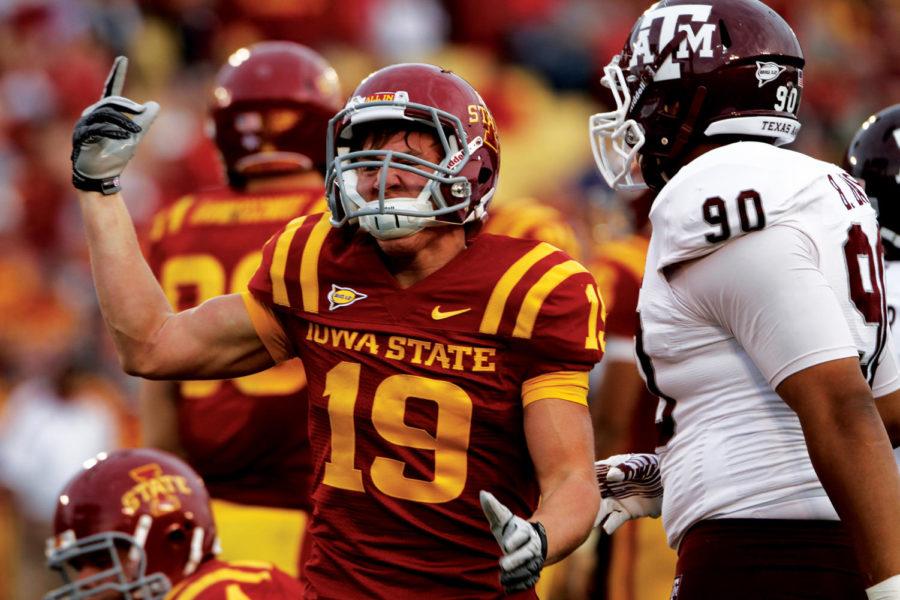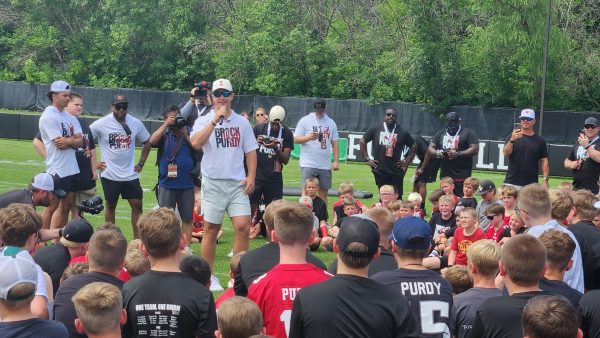NOTEBOOK: Receiving corps laden with depth
Photo: Tim Reuter/Iowa State Daily
Wide receiver Josh Lenz celebrates after making a successful reception during the game against Texas A&M on Satuday, Oct. 22. Lenz caught eight passed for a total of 117 yards in the game.
August 27, 2012
At Monday’s news conference, ISU coach Paul Rhoads answered more questions about the wide receivers than he had at any other point in the preseason.
With changes in the depth chart at two of the receiver slots, Rhoads said the greatest quality he has seen from the receiving corps heading into his team’s season-opening game against Tulsa on Saturday was production — both during and after the catch.
“We have three starters listed, but there could be six, even eight, that will see snaps on Saturday,” Rhoads said.
For a team that has typically been strapped for talent at the position, starting quarterback Steele Jantz will have more options come Saturday.
“I’ve kind of had an idea that we’re going to have a lot of guys subbing in and out,” Jantz said. “That’s good for us, especially since we go fast and guys get tired. So it’s nice having fresh legs.”
Rhoads also said senior Josh Lenz will have a chance to “blossom” this year with his return from injury.
“It’s strange to say with a senior, but he could have a breakout year just because he hasn’t been healthy the last couple seasons completely,” Rhoads said.
Last season, Lenz hauled in 39 catches, amassing 510 receiving yards and two touchdowns, averaging 42.5 receiving yards per game.
Lenz said Chris Young will get more playing time than last year and adds big-play opportunities with him and Aaron Horne as the two other starters.
“We’ve got a lot of guys at the receiver position right now that can do that,” Lenz said. “I think they just add to that.”
Along with the receivers, the tight ends will play a more involved role this season as well.
Rhoads said Ricky Howard, who emerged as the No. 1 tight end on the team’s latest depth chart, fulfills the “H-back” role — a tight end who lines up off the line of scrimmage, technically marking him as a player in the offensive backfield.
“He has the ability to move around; he’s a good blocker,” Rhoads said of Howard. “We’d like to put him in blocking positions not just at the traditional tight end — right there beside the tackle with his hand in the ground — we’d like him off the line of scrimmage; we’d like him moving; we’d like him in the backfield at times. And he catches the ball really well.”
Broomfield fills ‘hybrid’ backer position
Certain situations call for certain solutions.
For ISU defensive coordinator Wally Burnham, competing consistently with spread offenses that require more coverage from defensive backs and traditional offenses that require three-linebacker sets has called for the installment of a hybrid linebacker/defensive back to take the spot of the strong-side linebacker.
This season, Deon Broomfield heads into the team’s first game as the starting “hy-backer,” and he said he fills the role nicely.
“You’ve got to be physical and you’ve also got to have coverage skills and you’ve got to have some of the linebacker feel,” Broomfield said. “You’ve got to be able to come down in the box and be able to hit when you need to hit, so I feel I possess some of those characteristics coach Burnham was talking about.”
That “linebacker feel” is what distinguishes the “hy-backer” from the nickelback — who maintains the pedigree of a defensive back — in nickel situations against spread offenses that use more than three receivers.
This season, Broomfield and C.J. Morgan reprise their roles as the “hy-backer,” while A.J. Klein moves to strong-side linebacker with Jeremiah George assuming middle linebacker during the three-linebacker situation.
As for which defense the team plans on primarily using Saturday, Broomfield said it will depend.
“We’ve been working a lot with Jeremiah and the three-linebacker set, so it’s depending on the down and distance and personnel groupings,” Broomfield said.
Although Rhoads said he expects the base three-linebacker defense to be more of a norm this season, he said he would not bat an eye if George was left on the field during a situation that would call for the speedier “hy-backer” to come in.
“If we don’t have the opportunity to substitute and get the nickel on the field and end up with our base defense out there, it’s not going to cause us great concern the way Jeremiah’s filling in there,” Rhoads said.

















